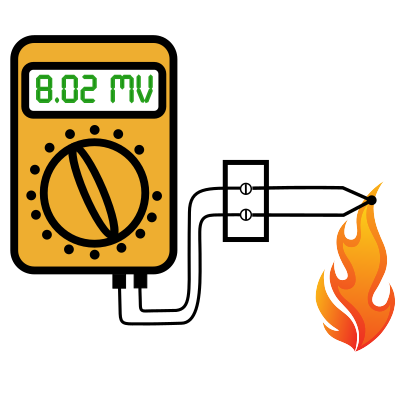
Have you ever tried to measure temperature using a thermocouple without a digital thermocouple thermometer? I have been there and it was painful so I would like to make it easier for all those who may have to do it. The most important thing you have to know about thermocouples is how they work, and the laws they follow. Once you understand that it all starts to make sense.
First – To make a thermocouple, you have to join together two different thermocouple wires together at one end. You can twist them, crimp them, or weld them, it makes very little difference as long as the two wires make good electrical contact. (I worked in a heat trace lab in my early years and we used small copper tabs that we crimped on the wires.)
(IOThrifty editor’s note: IOThrifty offers a line of thermocouple welders for making professional thermocouple welds. View our thermocouple welders.)
Second – How a thermocouple works? A thermocouple generates a small electrical voltage based upon the DIFFERENCE in temperature between the two ends; the end where you joined the two wires and are making the measurement is known as the “hot” end and the end that you measure the voltage is known as the “cold end”. Make voltage measurement at the cold end. No problem you think, the room is at 20°C and my hot end is near 100°C. You now have the thermocouple voltage from 20°C to 100°C. Close but not there yet. The voltage that a thermocouple makes is non-linear, so the voltage from 100°C to 120°C is different than 0°C to 20°C and you have to account for that to get an accurate MEASUREMENT. Another issue is that all thermocouple tables are referenced to the cold end being at 0°C. (A side note here, if you hold your meters leads to the thermocouple wires with your fingers, they are at your external body temperature not room temperature, so use alligator clips, not your fingers to keep the measurement accurate.)
Third – To address these two issues we need to go to the Thermocouple Laws. Why do we need to do this? Our cold end is 20°C and the established voltage tables are all based upon the “cold end” being at 0°C. Rather than go into the details of how to make and ice bath and transition junctions, you are saved by the thermocouple laws. The Law of successive or intermediate thermocouples says that the emfs (voltages) are additive. So, if our thermocouple is measuring from 20°C to 100°C the voltage from 0°C to 20°C plus the voltage from 20°C to 100°C equals the voltage from 0°C to 100°C so with the information we have, we can convert our measured emf to temperature. We need to look up the voltage from 0°C to 20°C and add that to the measured voltage from 20°C to 100°C and them look up that voltage in the table to get the temperature at the hot end. Now lets make that easy.
A link in this blog goes to a spread sheet that allows you to enter your Measured Voltage and the Cold Junction Temperature and then it does all the math and give you the temperature at the hot end. You can also use it backwards, by entering a temperature and get the 0°C referenced thermocouple voltage for that temperature. The table works for 8 thermocouple types; B, E, J, K, N, R, S, T. Hope this makes your life easier.
DJ
This excel spreadsheet will preforms the calculation of converting the millivolt output from a thermocouple to temperature (degrees C or F). It can also calculate the millivolt produced by a thermocouple for a given temperature.

